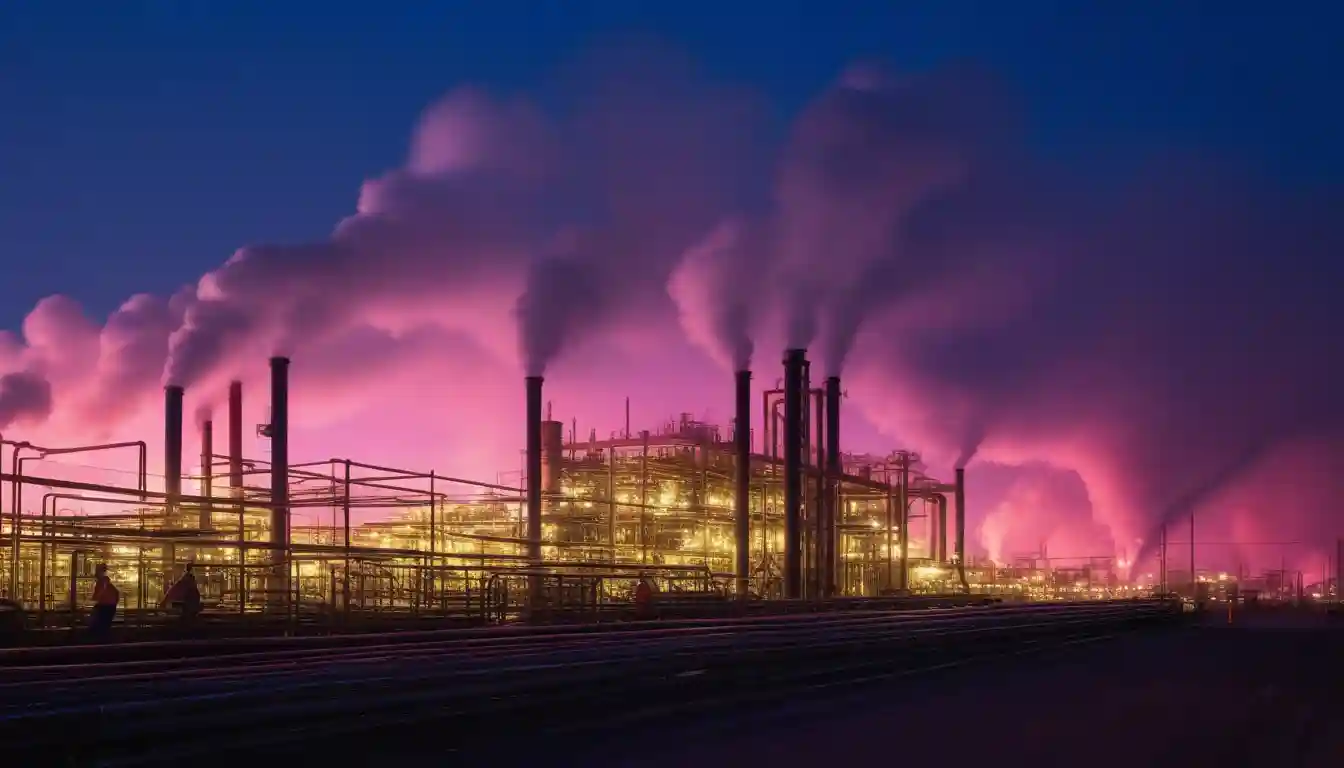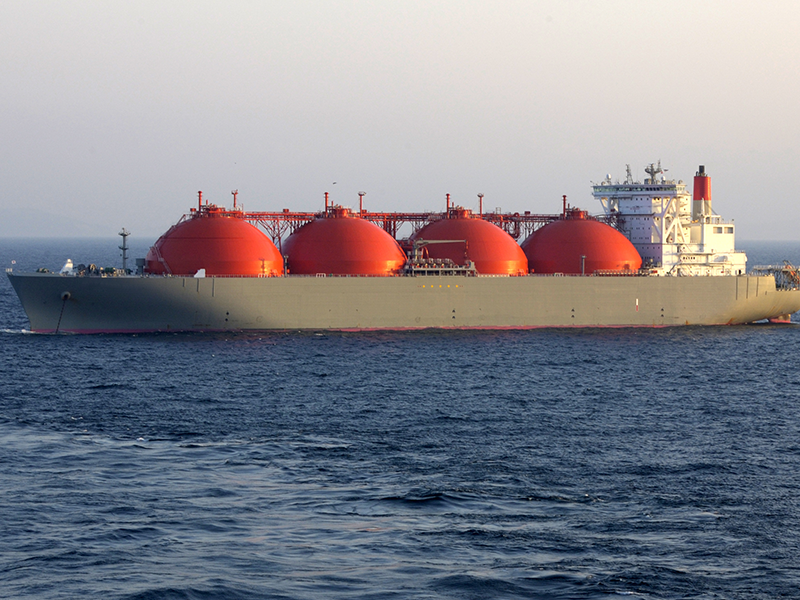
US Natural Gas Rises 2.7% After Production Drops to Six-Week Low Amid Strong Export Demand
When America's Energy Heartbeat Skipped: The Natural Gas Market's Quiet Revolution
HOUSTON — In the sprawling nerve centers where America's energy infrastructure is monitored around the clock, Thursday's anomaly emerged against a backdrop of seemingly stable fundamentals. Just eight days earlier, the Energy Information Administration had reported average U.S. dry natural gas production at 106.7 billion cubic feet per day for the week ending August 13—unchanged from the previous week and reflecting the steady operational rhythm that has characterized American energy markets throughout 2025. Yet now, daily production plummeted to 106.4 billion cubic feet, marking not just a departure from recent weekly averages but a six-week low that, in the grand scheme of America's energy abundance, shouldn't have registered as more than statistical noise.

But in the hyperkinetic world of natural gas trading, where algorithms parse every decimal and seasoned traders read market tea leaves in millisecond price movements, that production dip triggered something profound. Natural gas futures surged 2.73%, climbing 7.6 cents to $2.828 per million British thermal units—a technical breakout that illuminated the delicate new reality reshaping America's energy markets.
Daily price movement of U.S. natural gas futures, highlighting the 2% surge.
| Date | Open | High | Low | Settle | Change | % Change |
|---|---|---|---|---|---|---|
| Aug 20, 2025 | $2.758 | $2.777 | $2.729 | $2.752 | -0.014 | -0.51% |
| Aug 19, 2025 | $2.90 | $2.91 | $2.73 | $2.76 | -0.14 | -4.83% |
| Aug 18, 2025 | $2.88 | $2.92 | $2.80 | $2.91 | +0.03 | +1.04% |
The rally represented far more than a routine commodity bounce. It exposed the emergence of a fundamentally transformed market structure, where traditional seasonal patterns increasingly bend to the gravitational pull of global liquefied natural gas exports, and where even minor supply hiccups can generate outsized price responses.
"The market is telling us that the old playbook doesn't work anymore," said one veteran energy trader with three decades of experience, speaking on condition of anonymity. "We're operating in a new paradigm where global dynamics matter more than winter weather forecasts."
The Production Paradox: When Abundance Meets Anxiety
The immediate catalyst emerged from an unexpected contradiction at the heart of America's energy narrative. While Lower 48 production averaged a record-setting 108.4 billion cubic feet per day throughout August—a testament to the technological prowess that has made the United States the world's largest natural gas producer—Thursday's daily output revealed the first meaningful production volatility in weeks.
This wasn't the dramatic collapse that historically triggered price spikes. Instead, it represented something more subtle and potentially more significant: evidence that even America's seemingly unstoppable production machine operates within operational constraints that can create meaningful market impacts.
The production fluctuation coincided with inventory data that revealed the market's evolving fundamentals beneath surface-level abundance. Last week's projected storage injection of 22 billion cubic feet fell substantially below both the 35 billion cubic feet five-year average and the 29 billion cubic feet recorded during the same period last year. While overall inventories remain approximately 6% above historical norms—a buffer that historically provided market comfort—traders increasingly focused on weekly flow dynamics rather than absolute storage levels.
"We're seeing a market that's learning to price marginal changes differently," observed a senior commodities analyst at a major investment bank. "The absolute numbers still look comfortable, but the weekly variations are becoming more meaningful as export demand provides a consistent baseline."
Global Appetite Reshapes Domestic Reality
Perhaps the most significant underlying force driving Thursday's price action emerged from America's liquefied natural gas export infrastructure, which continues operating near maximum capacity. Average flows to the eight major U.S. LNG export facilities increased to 15.8 billion cubic feet per day in August, rising from July's 15.5 billion cubic feet per day as maintenance cycles concluded and operational efficiency improved.

This export strength represents more than infrastructure utilization—it reflects a fundamental rebalancing of global energy flows that has created what traders describe as a "new floor" for domestic natural gas prices. With international LNG prices maintaining substantial premiums over domestic natural gas, export facilities are operating at maximum economic efficiency, effectively creating a price discovery mechanism that connects previously isolated regional markets.
The transformation has been remarkably swift. Just five years ago, natural gas was primarily a domestic commodity, with pricing driven by local weather patterns, regional storage levels, and seasonal demand cycles. Today, America's export infrastructure has created what amounts to a global pricing mechanism, where domestic production competes directly with international demand.
(Dramatic growth of U.S. LNG exports over the past decade)
| Dimension | 2015–2016 baseline | 2023–2024 status | 2025–2026 outlook | Notes/Context |
|---|---|---|---|---|
| Scale of exports (average volumes) | 16 Bcf/d in 2026 as new capacity ramps | Rapid, order-of-magnitude increase within a decade | ||
| Export capacity (nominal/peak) | ~1 Bcf/d (2016) | ~11.4 Bcf/d nominal; ~14.0 Bcf/d peak (end-2023) | +~5.3 Bcf/d nominal from projects entering service; higher peak as facilities optimize | Reflects first wave complete and second wave underway |
| Key project additions | Sabine Pass initiated Lower-48 exports (2016) | Fleet optimization; Freeport return boosted 2023 volumes | Plaquemines Phase 1 (first cargo Dec 2024), Corpus Christi Stage 3 (first cargo Feb 2025), Golden Pass ramp 2025–2026 | Startup timing drives year-to-year averages |
| Global ranking | New entrant (2016) | Surpassed Australia and Qatar; top exporter in 2023 and maintained into 2024 | Expected to remain a leader as capacity expands | Ranking depends on peer project timelines and utilization |
| Destinations and trade flows | 17 countries (2016) | 43 countries by 2023; Europe dominant post-2022, Asia share varied with market | Continued European demand; Asian pull strengthens with price spreads | Destination-flexible contracts enhance reach |
| Drivers of demand | Early portfolio/spot growth | Post-2022 European substitution for Russian pipeline gas; strong utilization | Continued European security needs; portfolio balancing in Asia | Henry Hub-linked pricing and contract flexibility key |
| Policy and market implications | Emerging debates on approvals and climate impact | U.S. LNG reshaped global gas trade and pricing structures | Ongoing policy scrutiny on permitting, climate goals, and market alignment | DOE/EIA assessments inform trajectory |
| Data visibility | Initial monthly series begin with first exports | EIA time series show records into late-2023/2024 | Short-term outlooks integrate project ramp profiles | Monthly granularity captures maintenance and outages |
Industry specialists emphasize that physical capacity, rather than economic incentives, now represents the primary constraint on international sales. This dynamic has fundamentally altered domestic market behavior, creating what some analysts describe as a "safety valve" effect that prevents the dramatic price collapses that historically characterized periods of abundant supply.
The Widowmaker's Surprising Wisdom
The most intriguing signal emerging from Thursday's trading appeared in the commodity's forward curve—specifically the March-April 2026 spread known among traders as the "widowmaker" for its notorious volatility during winter months. This spread compressed to a record low of approximately 13 cents, suggesting that market participants have largely dismissed traditional winter supply risk premiums.
Did you know? In natural gas trading, the “widowmaker” is the notoriously volatile spread between the March and April NYMEX futures—the last winter withdrawal month versus the first spring injection month—used to bet on how tight supplies will be at winter’s end. Because gas demand hinges on late‑season weather, storage levels, production, and infrastructure, a surprise cold snap or outage can make March prices surge relative to April, or collapse just as quickly. Traders often go “long widowmaker” by buying March and selling April to profit from tighter end‑winter conditions—and reverse it if they expect comfortable storage—but sudden forecast shifts can swing the spread dramatically, earning it a reputation for punishing the unprepared.
This pricing structure represents a psychological transformation as significant as any physical infrastructure change. Historically, winter spreads commanded substantial premiums as traders hedged against potential supply disruptions, extreme weather events, or unexpected demand spikes. The current compression suggests that abundant storage levels, robust production capacity, and consistent export demand have effectively eliminated traditional winter scarcity concerns.
However, some market veterans view this spread compression as potentially creating its own vulnerabilities. When markets price out tail events completely, they can become susceptible to unexpected disruptions that weren't adequately hedged—a dynamic that has historically preceded significant market corrections.
"The widowmaker spread is telling us that the market has become very comfortable with winter supply security," noted one energy hedge fund manager. "But comfort can become complacency, and complacency creates opportunity."
Investment Landscape: Navigating the New Equilibrium
For investment professionals navigating this transformed market, the current natural gas environment presents analytical challenges that transcend traditional commodity investment frameworks. The fundamental backdrop suggests a market transitioning from domestic seasonal patterns toward globally integrated pricing mechanisms driven primarily by export infrastructure capacity rather than regional storage cycles.
Market participants increasingly recognize that traditional natural gas investment approaches may require substantial revision. The historical emphasis on winter heating demand, regional storage differentials, and weather-driven volatility may prove secondary to export infrastructure utilization, global LNG market dynamics, and production operational efficiency.
The production volatility observed Thursday, while potentially temporary, highlights the growing importance of operational resilience in investment calculations. Companies demonstrating diversified production portfolios, robust operational protocols, and strategic positioning near export infrastructure may command premium valuations in an environment where minor supply disruptions generate amplified price responses.
From a strategic portfolio perspective, the current environment appears to favor investments in midstream infrastructure, particularly LNG export facilities and associated pipeline capacity. These assets benefit from stable, long-term contracts that provide cash flow predictability regardless of short-term commodity price fluctuations, while participating in the long-term growth of global energy trade.
The evolving market structure also suggests opportunities in companies positioned to benefit from operational efficiency improvements and technological innovation in production processes. As markets become more sensitive to marginal production changes, operational excellence becomes increasingly valuable.
Charting Tomorrow's Energy Markets
The natural gas market's evolution toward export-driven pricing creates analytical frameworks that may prove more relevant than traditional seasonal models. While domestic demand patterns remain important, they increasingly operate within constraints imposed by global market dynamics and export infrastructure capacity utilization.
Market participants should monitor several key indicators that may provide early signals of significant trends: the persistence of production variability, the stability of LNG export flows relative to capacity, the behavior of storage injection rates compared to historical patterns, and the development of additional export infrastructure.
The current market structure—characterized by abundant storage, robust export demand, and occasional production volatility—may represent a new equilibrium that rewards investment strategies focused on operational efficiency, infrastructure quality, and global market positioning rather than traditional weather-based seasonal trading.
This transformation reflects broader changes in global energy markets, where technological innovation, infrastructure development, and evolving geopolitical relationships continue reshaping traditional commodity trading paradigms.
Investment Disclaimer: This analysis represents informed market commentary based on current data and established economic indicators. Market conditions may change rapidly, and past performance does not guarantee future results. Readers should consult qualified financial advisors for personalized investment guidance tailored to their specific circumstances and risk tolerance.